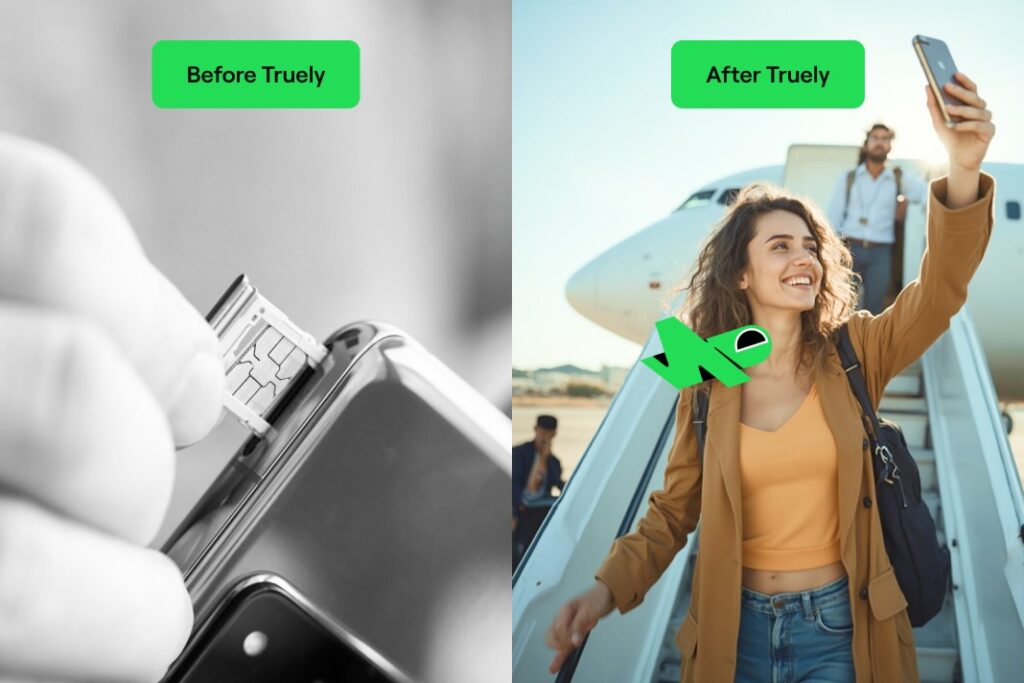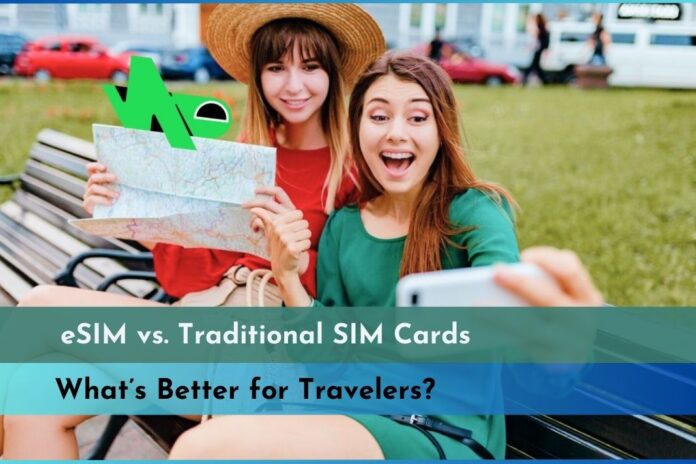Staying connected while traveling is more important than ever. Whether you’re navigating a new city, sharing your adventures, or keeping in touch with family, reliable mobile service is essential.
For years, travelers have relied on traditional SIM cards to stay connected abroad. But with the rise of eSIM technology, things are starting to change. So, which is better for travelers—traditional SIM cards or eSIMs? Let’s explore the differences and help you decide the best option for your next trip.
How Travelers Use Traditional SIM Cards for Connectivity
If you’ve ever traveled internationally, you’ve probably dealt with the hassle of traditional SIM cards. After landing in a new country, one of your first stops is often a local mobile shop or airport kiosk to buy a SIM card. This gives you access to local calls, texts, and data at affordable rates, avoiding the sky-high roaming fees from your home carrier.
Once you get your SIM card, you need to remove your original one, store it safely (and hope you don’t lose it), and swap in the new one. Depending on how long you stay and how much data you use, you might have to top it up, which could mean navigating a foreign language or currency.
And if you’re hopping between multiple countries, you’re looking at repeating this process over and over. Not to mention, you’ll likely end up with a collection of tiny SIM cards that are easy to misplace.
While this method has worked for many travelers for years, it’s not without its drawbacks. It’s time-consuming, and depending on where you are, finding a reliable SIM card with good coverage can be tricky. However, for those who prefer having a physical card and don’t mind the occasional hassle, traditional SIM cards are still a popular option.
How Travelers Are Using eSIMs Today
In contrast, eSIMs offer a modern, flexible solution for staying connected while traveling. An eSIM, or embedded SIM, is built into your phone or device, meaning you can download a mobile plan digitally without the need for a physical SIM card. This technology has opened up a whole new world of convenience for travelers.
Before even leaving your home country, you can choose and download an eSIM plan that’s tailored to your destination. No more searching for SIM card shops or dealing with the stress of language barriers at the airport. With a service like Truely eSIM, you can activate a data plan the moment your plane touches down, ensuring you’re connected from the get-go.
Plus, many travelers are finding eSIMs to be more cost-effective. Rather than paying inflated rates for temporary SIM cards or tourist plans, you can browse and compare eSIM plans ahead of time to find the best deal.
For instance, with eSIM India, you can choose between 1GB to 20 GB plans, all without the usual hassles of buying a physical SIM card or going through the KYC process.
Comparing eSIMs and Traditional SIM Cards for Travelers

Now that we’ve covered the basics, let’s look at how eSIMs and traditional SIM cards compare in the areas that matter most to travelers.
1. Convenience
- Traditional SIM Cards: With traditional SIM cards, you’ll need to buy a new one every time you enter a different country. You’ll also have to deal with swapping out cards, storing the old ones, and making sure you don’t lose them. If you’re visiting multiple countries, this process can quickly become a hassle.
- eSIMs: eSIMs offer maximum convenience. You can purchase your plan before your trip, and connect the moment you land.
2. Flexibility
- Traditional SIM Cards: Traditional SIM cards typically lock you into a single carrier. If you’re traveling to multiple countries, you may need to carry multiple SIM cards and switch them out as you move from one place to another.
- eSIMs: eSIMs are much more flexible. You can store multiple plans from different carriers on a single eSIM and switch between them based on where you are. This makes eSIMs perfect for frequent travelers who are always on the move. With Truely eSIM, for example, you can easily switch data plans in just a few taps.
3. Cost Efficiency
- Traditional SIM Cards: Using traditional SIM cards while traveling often means paying for local SIMs in each country, which can add up. Plus, there’s always the risk of getting stuck with overpriced cards if you buy them at airports or tourist hotspots.
- eSIMs: eSIMs typically offer more transparent and competitive pricing. You can compare plans online in advance and choose the one that best fits your budget and data needs. Services like Truely eSIM offer affordable plans for various countries and regions, helping you avoid overpriced local SIMs.
4. Security
- Traditional SIM Cards: Losing a physical SIM card while traveling can be a real headache. If you misplace it, you could lose access to your phone number or data until you replace the card.
- eSIMs: Since eSIMs are embedded in your phone, there’s no risk of losing or damaging them. With Truely, even if you somehow lose your device and accidentally delete your esIM, they can restore it for you with all your active plans, so nothing is lost.
5. Compatibility
- Traditional SIM Cards: Most phones still support traditional SIM cards so compatibility is rarely an issue as long as your phone isn’t carrier-locked.
- eSIMs: While not all phones currently support eSIMs, the technology is becoming increasingly common. Most modern smartphones, including newer iPhones and flagship Android devices, are equipped with eSIM capabilities. As this technology continues to grow, compatibility will only become less of an issue.
When a Traditional SIM Card Might Still Make Sense
Traditional SIM cards are still a viable option for some travelers, especially if your device doesn’t support eSIM technology. Additionally, if you’re someone who prefers having a physical card or a separate device for connectivity, then a traditional SIM card could still work for you.
When eSIMs Are the Better Choice
If you’re a frequent traveler, a digital nomad, or simply someone who wants a hassle-free way to stay connected, eSIMs are the better choice. Their convenience, flexibility, and cost efficiency make them an ideal solution for modern travel.
Final Thoughts: eSIMs Are the Future of Travel Connectivity
As travel becomes more streamlined and tech-driven, eSIMs are fast becoming the go-to solution for travelers who want to stay connected with ease. While traditional SIM cards have served their purpose for many years, eSIMs offer a more flexible, convenient, and secure way to stay online.
Before your next adventure, consider switching to an eSIM and experience the future of travel connectivity. Whether you’re exploring new places or revisiting old favorites, an eSIM ensures you’re always connected, no matter where you go.
Discover more from Travel n' Thrill
Subscribe to get the latest posts sent to your email.














